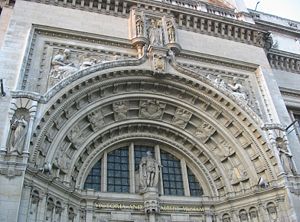- Alfred Drury
-
(Edward) Alfred Briscoe Drury, (1856–1944)[1][2] was an English architectural sculptor and figure in the New Sculpture movement.
Born in London, Drury studied under Edouard Lanteri and Jules Dalou, with whom he worked between 1881 and 1885, and then became assistant to Joseph Boehm.
Drury is best represented at the Victoria and Albert Museum, where he contributed the figure of Prince Albert immediately above the main entrance, nine lunettes with Drury's characteristic allegorical girls each bearing a portion of the museum's motto, allegorical figures of Inspiration and Knowledge, and Queen Victoria above it all, carrying a staff and flanked by a knight and angel. (The spandrel figures of Truth and Beauty are by George Frampton.)
His major work includes:
- four allegorical pairs on the Old War Office, Whitehall, 1905, representing Sorrow and Joy, Horror and Dignity of War, Truth and Justice, and Victory and Fame
- four colossal bronzes on the downstream side of the Vauxhall Bridge representing Education, Fine Art, Science, and Local Government
- a figure of Joshua Reynolds for the forecourt of Burlington House, home of the Royal Academy
Notes
- ^ Chamot, p. 157.
- ^ Mark Stocker, ‘Drury, (Edward) Alfred Briscoe (1856–1944)’, Oxford Dictionary of National Biography, Oxford University Press, Sept 2004
References
- Mary Chamot, The modern British paintings, drawings, and sculpture, London, Oldbourne Press, 1965. OCLC 512918
- online biography
- Alfred Drury Some details and photographs of Drury's work on The National Archives website.
Categories:- 1859 births
- 1944 deaths
- British architectural sculptors
- English sculptors
- Royal Academicians
Wikimedia Foundation. 2010.


